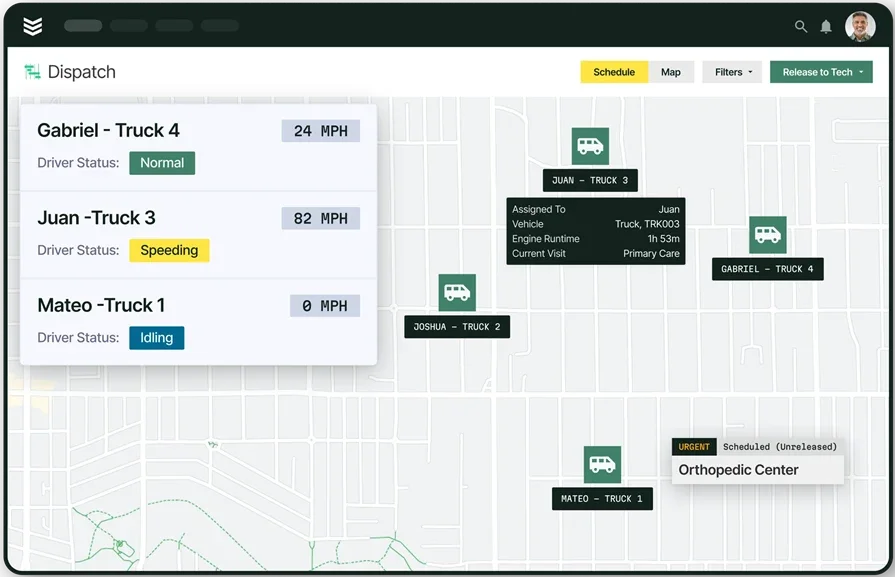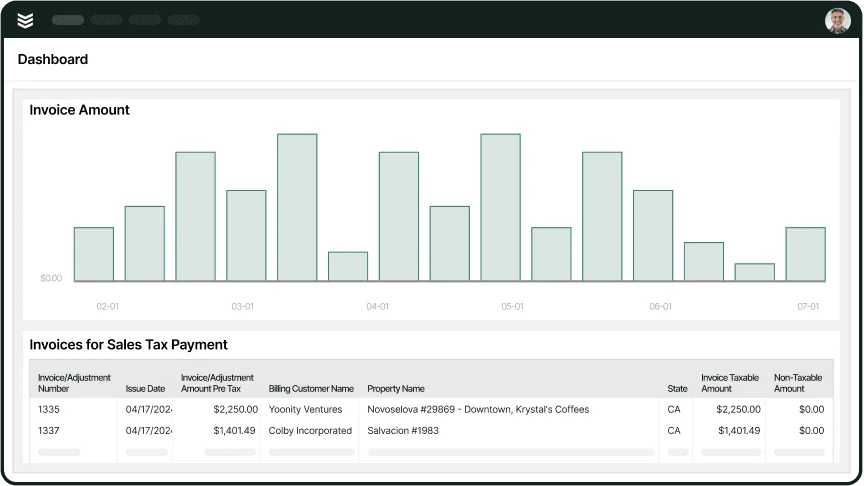Efficient field service routing keeps your crew moving and your business running at full speed. Every job needs the right tech, the right tools, and the fastest route to get there—without wasted miles or delays. But anyone in the field service industry knows it’s not as simple as plugging an address into a GPS.
Traffic, last-minute schedule changes, and unexpected job complexities can turn a well-planned day into chaos. That’s why mastering field service routing is critical for service techs, contractors, service managers, and business owners looking to cut costs, improve response times, and keep customers happy.
- What is field service routing?
- 7 benefits of mastering field service routing
- 10 field service route optimization best practices to follow
- Types of tools for field service routing
- Best field service routing solutions
Getting a handle on field service routing starts with understanding what it actually means. Before we dive into the strategies and tools that make it work, let’s break down the basics.
What is field service routing?
Field service routing is the process of planning and optimizing technician travel paths. It ensures the right tech reaches the right job on time, reducing delays and boosting efficiency. A well-optimized system accounts for job priority, location, availability, and real-time traffic conditions.
In field service management, routing plays a crucial role in cutting fuel costs, improving response times, and increasing daily job completion rates. When paired with smart scheduling and dispatching tools, it eliminates wasted time on the road and helps teams operate at peak performance.
How the field service routing process works
Routing field service teams used to mean printing out schedules, hoping for the best, and dealing with constant delays. Now, advanced field service management software takes the guesswork out of the process. It automatically assigns the right tech to the right job while optimizing travel routes in real-time.
Here’s how the process works:
- Job intake and scheduling: Service requests come in, and jobs are assigned based on urgency, location, and technician availability.
- Route planning and optimization: The system maps out the most efficient routes, reducing unnecessary travel time and fuel costs.
- Real-time dispatching: Field technicians receive job details instantly on their mobile devices, ensuring they arrive prepared.
- Live tracking and adjustments: GPS tracking helps dispatchers monitor job progress and make real-time adjustments when delays happen.
- Completion and reporting: Once the job is done, technicians update work orders, collect signatures, and submit reports directly from the field.
The future of field service routing
Field service routing is evolving fast, with AI-driven dispatching, automation, and real-time route adjustments becoming the new standard. Today’s field service routing software doesn’t just map out job sites—it actively optimizes operations across industries like HVAC, plumbing, electrical, refrigeration, and fire safety. By factoring in job priority, live traffic, and technician skills, it ensures teams reach more job sites with less downtime.
For HVAC and refrigeration, smart routing helps techs respond faster to emergency repairs and scheduled maintenance. In plumbing and electrical, it cuts travel time between service calls, maximizing daily job capacity. Fire safety companies benefit from precise scheduling for inspections and compliance work, reducing delays and missed appointments.
As AI and predictive analytics advance, field service routing software will go beyond navigation—it will anticipate job needs, dynamically adjust schedules, and recommend preventative maintenance before breakdowns happen. Companies that invest in these tools now will see fewer delays, lower fuel costs, and more satisfied customers.
7 benefits of mastering field service routing
Mastering field service routing is a game changer for businesses that rely on dispatching technicians efficiently. Whether you’re managing HVAC, plumbing, electrical, refrigeration, or fire safety teams, getting the right techs to the right job—without wasted time or miles—makes a massive difference. From lowering costs to boosting customer satisfaction, here are seven key benefits—plus real-world examples of how optimized routing improves daily operations.
1. Faster response times
Optimized routing ensures urgent service calls—like HVAC breakdowns or electrical failures—get handled first. Instead of scrambling to find an available tech, dispatchers can automatically assign the closest qualified technician. A commercial HVAC company, for example, cut emergency response times in half during a summer heatwave by using dynamic routing to send the nearest technician immediately.
2. More jobs completed per day
Less time on the road means more time on-site. Routing software helps businesses increase daily job capacity without overloading technicians. A plumbing company that struggled with inefficiencies discovered they could fit three additional service calls into their schedule each day just by reducing unnecessary travel time between jobs.
3. Reduced fuel and vehicle costs
Smart routing minimizes unnecessary mileage, cutting fuel expenses and reducing wear and tear on service vehicles. An electrical contractor, for instance, noticed a significant drop in fuel costs after implementing optimized routes that eliminated excessive back-and-forth travel across the city.
4. Better technician productivity
With automated scheduling and dispatching, techs spend less time driving and more time doing actual service work, boosting overall efficiency. A refrigeration company that previously lost 20% of its work hours to inefficient travel was able to reallocate that time toward more service calls after implementing an advanced routing system.
5. Improved customer satisfaction
Clients appreciate on-time arrivals and quick service. Efficient routing prevents delays and missed appointments, keeping customers happy. A fire safety inspection company, for example, reduced appointment no-shows by 30% after using real-time routing updates to notify customers of their technician’s estimated arrival time.
6. Lower operational costs
Fewer unnecessary trips and better workforce management lead to significant savings on labor and overhead costs. A plumbing business struggling with high overtime expenses reduced its labor costs by optimizing service routes, ensuring techs could complete their assignments within regular work hours.
7. Stronger workforce management
Real-time tracking and optimized scheduling help balance workloads, prevent burnout, and ensure the right tech is assigned to the right job. An electrical service company found that by using AI-powered routing, they could distribute assignments more evenly across their team, preventing technician fatigue and improving overall job satisfaction.
Expert Tip
Routing plays a huge role in field service management by making operations smoother, more cost-effective, and better for both customers and technicians. Check out the benefits of field service management to learn more. Now, let’s look at the best practices to optimize your field service routing for even greater efficiency.
10 field service route optimization best practices to follow
Field service routing directly impacts efficiency, costs, and customer satisfaction. The right approach ensures your HVAC, plumbing, electrical, refrigeration, or fire safety teams complete more jobs with fewer delays. Below are 10 best practices to optimize your field service routes and keep operations running smoothly.
1. Use real-time route optimization
Static schedules don’t account for traffic, delays, or last-minute job changes. A dynamic routing system recalculates the best routes on the fly, preventing technicians from wasting time on inefficient travel.

BuildOps is smarter routing optimization
Auto-optimize field service routing as soon as new jobs come up.
2. Prioritize jobs based on urgency and location
Not all service calls are equal. Emergency repairs should take priority, while routine maintenance can be scheduled around them. Smart routing ensures urgent jobs don’t get delayed due to inefficient scheduling.
3. Balance workloads across your team
Overloading certain technicians while others sit idle leads to burnout and inefficiency. AI-powered routing distributes assignments evenly, ensuring fair workloads and improving overall productivity.
4. Minimize backtracking and unnecessary travel
Poorly planned routes often send techs crisscrossing a service area, wasting fuel and time. Optimized routing clusters jobs by location, cutting travel time between stops.
5. Automate scheduling and dispatching
Manual scheduling is time-consuming and prone to errors. Automating the process ensures technicians receive the right assignments instantly, reducing administrative workload and improving response times.
6. Leverage GPS tracking for real-time adjustments
Knowing where your techs are at all times allows dispatchers to make on-the-fly adjustments when cancellations or emergency calls come in, keeping the day running smoothly.
7. Improve technician preparedness
Routing is only effective if techs show up ready. Pre-job briefings, mobile access to work orders, and automated inventory tracking help ensure technicians have the right tools and parts when they arrive.
8. Enhance communication between dispatchers and techs
Miscommunication leads to delays. A seamless communication system allows technicians to receive updates, report job status, and request support without unnecessary back-and-forth.
9. Analyze routing data to find inefficiencies
Tracking time on-site, drive time, and completed jobs helps identify inefficiencies. Businesses that regularly review routing data can tweak schedules, reduce costs, and improve customer service.
10. Choose the right field service platform
The best routing system is only as strong as the software behind it. Investing in a field service management platform with built-in route optimization lays the foundation for long-term efficiency.
Deep Dive
Optimizing field service routing doesn’t happen in isolation—it starts with the technology that powers your operation. Companies that focus on field service optimization see the biggest improvements in efficiency, response times, and overall profitability.
Next, let’s explore the types of tools that make optimized routing possible.
Types of tools for field service routing
Field service routing relies on key software tools to keep operations running smoothly. Without them, businesses risk delays, wasted fuel, and frustrated customers. The right technology ensures HVAC, plumbing, electrical, refrigeration, and fire safety teams reach job sites on time with everything they need. Here are four essential tools that drive efficient routing:
1. Scheduling
Scheduling software is the foundation of field service routing, ensuring jobs are assigned based on availability, urgency, and location. A well-optimized field service scheduling system reduces downtime between appointments and maximizes technician productivity.
2. Dispatching
A strong dispatching system connects office staff with field techs in real-time, allowing for last-minute job changes, reroutes, and emergency response coordination. Field service dispatching software helps businesses react quickly while keeping schedules tight and efficient.
3. Fleet management
Managing vehicles is just as important as managing people. Fleet tracking tools monitor vehicle locations, fuel usage, and maintenance needs, preventing costly breakdowns and delays. A field service fleet management system ensures your vehicles are running efficiently while optimizing technician routes.
4. Time tracking
Keeping track of technician hours helps businesses manage labor costs and identify inefficiencies. With field service time tracking software, companies can monitor work hours, improve payroll accuracy, and ensure jobs are completed on time.
These tools work together to create a seamless field service routing system, cutting wasted time and improving overall job efficiency. Next, let’s look at some of the best solutions available for field service routing.
Best field service routing solutions
Choosing the right field service routing software can make or break your operation. The best tools don’t just plan routes—they integrate scheduling, dispatching, fleet management, and real-time tracking to keep teams on the move and jobs running smoothly.
A well-designed system helps HVAC, plumbing, electrical, refrigeration, and fire safety companies cut downtime, reduce fuel costs, and increase job efficiency. Check out our guide to the best field service routing software for a full breakdown of top solutions.
7 features to look for in a field service routing tool
To ensure field service businesses get the most out of their system, here are seven must-have features to look for:
- Advanced scheduling - A strong field service scheduling system organizes jobs based on priority, location, and technician availability. It prevents double bookings, reduces scheduling gaps, and improves response times. Plumbing contractors handling emergency leak repairs rely on scheduling tools to prioritize urgent jobs over routine maintenance, ensuring critical issues get resolved first. Learn more about field service scheduling and how it keeps teams efficient.
- Smart dispatching - Efficient dispatching ensures the right tech is assigned to the right job, reducing unnecessary travel. A construction dispatching system allows real-time updates, letting managers reroute technicians when job details change. HVAC teams often deal with last-minute cancellations or urgent AC failures, and a strong dispatching tool helps them respond quickly. See how field service dispatching improves job efficiency.
- Fleet management and GPS tracking - Keeping track of service vehicles prevents delays, lowers fuel costs, and ensures the closest technician is dispatched. Refrigeration companies servicing large grocery stores use fleet tracking to monitor vehicle locations and prevent unnecessary downtime. With fleet management for field service, businesses can optimize vehicle performance and route efficiency.
- Mobile access for technicians - A mobile-friendly field service tool lets technicians receive job details, update statuses, and complete paperwork from the field—no need for office visits. Electrical contractors servicing commercial properties save hours each week by submitting digital reports instead of driving back to the office. A field service technician mobile app ensures real-time communication and job tracking.
- Automated invoicing and payments - Faster invoicing means better cash flow. Automated invoicing linked to completed jobs ensures customers are billed accurately and promptly. Fire safety companies handling routine inspections use integrated invoicing to reduce administrative work and speed up payments. Explore how field service invoicing streamlines the payment process.
- Customer and service agreements management - Keeping track of recurring jobs and service contracts ensures no appointment is missed. HVAC companies managing long-term maintenance contracts need automated reminders and tracking. A service agreement tool for field service helps businesses manage recurring work without missing critical deadlines.
- Reporting and performance analytics - Strong reporting tools for field service teams track job efficiency, technician performance, and customer satisfaction. Plumbing businesses analyzing travel time and job completion rates use reporting features to fine-tune their routing strategies. Learn more about field service reporting to optimize performance.
Investing in field service routing software is about more than just getting from point A to point B—it’s about running a smarter, more efficient business. Up next, we’ll break down the top three field service routing solutions available today.
3 top field service routing software
The best tools streamline scheduling, optimize dispatching, and enhance real-time tracking—but the right choice depends on the type of work your business handles. Below are three top solutions, each designed for a different type of contractor:
1. Best for commercial contractors: BuildOps
BuildOps is built specifically for commercial field service contractors, offering an all-in-one platform that integrates scheduling, dispatching, and job management. It eliminates manual processes, ensuring that large-scale operations—like HVAC, electrical, plumbing, and fire safety companies—operate at peak efficiency. The software features AI-powered route optimization, technician tracking, and automated job assignments, making it easier to handle high-volume service calls without delays.
What Sets It Apart for Commercial Contractors: BuildOps is designed to handle the complexity of multi-location service contracts, large technician teams, and compliance-heavy industries. With real-time updates, route optimization, and advanced job tracking, commercial contractors can improve response times and reduce wasted travel.

Take a closer look at BuildOps
Route techs to field sites with precision, adjusting on the fly to stay on schedule.
2. Best for residential contractors: OptimoRoute
Image Source: OptimoRoute
OptimoRoute is a top choice for residential service contractors needing route planning, real-time updates, and automated scheduling. The software ensures that technicians in industries like HVAC, plumbing, and appliance repair can maximize job efficiency while reducing travel time. With drag-and-drop scheduling and dynamic re-routing, it helps smaller teams adapt quickly to last-minute job changes.
While OptimoRoute is great for residential contractors handling frequent, short-duration jobs, it may not be the best fit for companies managing complex service contracts or multi-phase projects. Businesses needing deeper integrations for invoicing, job costing, or advanced workforce management might find their capabilities somewhat limited.
What Sets It Apart for Residential Contractors: OptimoRoute is ideal for businesses that handle frequent, short-duration jobs across large service areas. It offers automated daily route optimization and customer notifications, keeping homeowners informed about technician ETAs.
3. Best for general contractors: Fieldpoint
Image Source: Fieldpoint
Fieldpoint is a powerful solution for general field service contractors managing both one-off jobs and long-term projects. The platform integrates job costing, scheduling, and dispatching with built-in reporting tools to improve workforce efficiency. It’s widely used in construction, mechanical services, and facilities maintenance, helping businesses optimize resource allocation.
Fieldpoint offers strong project-based routing and job costing, but its complexity may be overwhelming for smaller teams or businesses needing quick, day-to-day scheduling solutions. Contractors looking for a more intuitive, field-friendly interface might find other options better suited for their needs.
What Sets It Apart for General Contractors: Fieldpoint excels at project-based service routing, workforce scheduling, and tracking job profitability. Its custom workflows and job costing tools make it a strong choice for contractors managing both scheduled maintenance and large-scale service projects.
Mastering field service routing isn’t just about finding the shortest path—it’s about running a smarter, more efficient operation. From scheduling and dispatching to fleet management and invoicing, the right tools help businesses reduce wasted time, lower costs, and improve customer satisfaction. While many routing solutions focus on navigation alone, the best systems integrate real-time tracking, job management, and automation to keep field teams operating at peak efficiency.
For commercial contractors, managing complex service schedules, high-volume work orders, and multi-location contracts requires more than just basic routing. An all-in-one platform like BuildOps streamlines the entire field service process, helping businesses optimize routes while also improving job tracking, technician coordination, and overall operational performance. Unlike many standalone tools, it combines advanced routing with scheduling, dispatching, and reporting, ensuring teams stay productive and profitable.

Curious how BuildOps works?
We help teams run more efficient field service routing, boosting profits.







